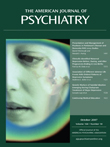To The Editor: The article by Guilherme Polanczyk, M.D., et al.
(1), in the June 2007 issue of the
Journal, provides important insights pertaining to the worldwide prevalence of childhood attention deficit hyperactivity disorder (ADHD). Dr. Polanczyk et al. convincingly argued that symptoms of ADHD may have a more constant geographic prevalence than previously thought. However, the accompanying editorial may have overestimated the implications of these findings
(2) .
The statement that a constant prevalence of ADHD symptoms argues in favor of “ADHD’s identity as a bona fide mental disorder, as opposed to a social construction” (
2, p. 856) may be misinterpreting the nature of psychiatric nosology. The concept of a disorder and its diagnostic criteria are social constructions by definition, and the fact that a group of symptoms has a constant geographic prevalence has little to do with what leads these symptoms to be considered a diagnostic entity. Twin pregnancies, for example, are observed worldwide with limited prevalence variation; however, being a twin in some indigenous cultures in Africa and South America could lead a child to be left to die or to be attributed with supernatural powers, whereas the same biological occurrence has far less relevance in modern Western society. Thus, universal phenomena can be viewed as normal or dysfunctional according to cultural beliefs.
Perhaps the best way to judge whether ADHD is a social construction, therefore, is not to look at the worldwide prevalence of its symptoms, but rather to evaluate the prevalence of its recognition and treatment. In this area, differences are striking. The per capita consumption of methylphenidate in the United States between 2003 and 2005 was approximately six times greater than that of Australia, eight times greater than that of Spain, and 18 times greater than that of Chile
(3) . If the prevalence of hyperactive symptoms is indeed similar among these countries, this probably means that a “hyperactivity disorder” deserving treatment in one country is seen by parents and physicians as a nonmedical condition (perhaps at the higher end of the “childhood activity spectrum”) elsewhere.
It is in defining such a diagnostic threshold that lies the social construction, as the boundaries of normality in a given region are set by psychiatrists (by choosing and applying diagnostic criteria) and society (by recognizing symptoms as deserving of medical care). Thus, it is probably not useful to ask whether DSM-IV has too low a threshold for ADHD or whether ICD-10 has too high a threshold, since there is little evidence of a biological threshold to be identified; the definition of such a threshold is the collective social duty of physicians, parents, and society. It is crucial that we acknowledge not only the existence of this construction, but also the responsibilities inherent in taking part in it. Symptoms might be constant throughout the world, but it is how we view them that will give them meaning and define the care of children worldwide.

